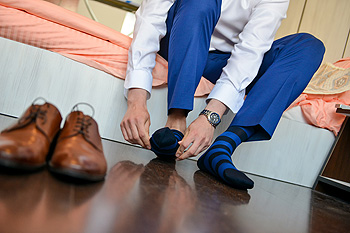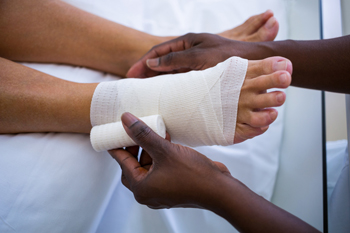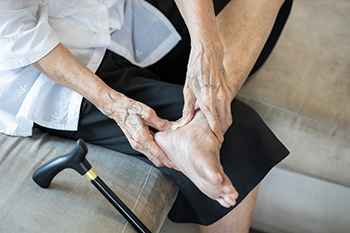Items filtered by date: August 2022
How to Find the Right Shoes

The shoes you wear play an important role in the health of your feet. Improperly fitting shoes can contribute to the development of corns, calluses, bunions, and hammertoes. Besides reducing the pain from a foot deformity or gait problem, well-fitted shoes can also help prevent these conditions from becoming worse. Following are a few ways to increase the chances of finding the right shoe for your feet. Try on shoes at the end of the day, when your feet will be the largest. Bring with you any orthotics you may need, as well as the socks or foot coverings you are likely to wear with that shoe. Have your feet measured, and if one foot is larger, choose that size. Stand in the shoes, and walk around a bit to see how they feel. If the shoe is too tight or too loose in the store, try a different size or a different style. Look for shoes with ample room in the toe box, and avoid high heels. Also look for shoes with mesh uppers that allow the feet to breathe and those that provide cushioning to the heel and ball of the foot. If you have preexisting conditions of the feet, it is a good idea to seek the guidance of a podiatrist before purchasing your footwear.
It is important to find shoes that fit you properly in order to avoid a variety of different foot problems. For more information about treatment, contact one of our podiatrists from Toms River Podiatrist . Our doctors will treat your foot and ankle needs.
Proper Shoe Fitting
Shoes have many different functions. They cushion our body weight, protect our feet, and allow us to safely play sports. You should always make sure that the shoes you wear fit you properly in order to avoid injuries and deformities such as: bunions, corns, calluses, hammertoes, plantar fasciitis, stress fractures, and more. It is important to note that although a certain pair of shoes might be a great fit for someone else, that doesn’t mean they will be a great fit for you. This is why you should always try on shoes before buying them to make sure they are worth the investment. Typically, shoes need to be replaced ever six months to one year of regular use.
Tips for Proper Shoe Fitting
- Select a shoe that is shaped like your foot
- Don’t buy shoes that fit too tight, expecting them to stretch to fit
- Make sure there is enough space (3/8” to ½”) for your longest toe at the end of each shoe when you are standing up
- Walk in the shoes to make sure they fit and feel right
- Don’t select shoes by the size marked inside the shoe, but by how the shoe fits your foot
The shoes you buy should always feel as good as they look. Shoes that fit properly will last longer, feel better, and improve your way of life each day.
If you have any questions, please feel free to contact our office located in Toms River, NJ . We offer the newest diagnostic and treatment technologies for all your foot care needs.
Why Does Gout Develop?

A form of arthritis known as gout can cause severe pain and discomfort and many people have difficulty in walking. Gout develops because of excess uric acid in the blood and may result from genetic factors or eating foods that have high levels of purines. These foods can include shellfish, red meat, alcohol, or drinks that are made with large amounts of sugar. This can cause crystals to develop in the joints of the big toe and may cause debilitating pain as well as redness and swelling. For many people, maintaining a healthy eating regimen can limit the number of gout attacks. It can help to drink plenty of fresh water daily and to engage in a gentle stretching and exercise program. It is beneficial to find out why they may be recurring and learn about methods to control them. If you have gout, it is strongly advised that you are under the care of a podiatrist who can guide you toward correct treatment options and educate you about effective preventive methods.
Gout is a foot condition that requires certain treatment and care. If you are seeking treatment, contact one of our podiatrists from Toms River Podiatrist . Our doctors will treat your foot and ankle needs.
What Is Gout?
Gout is a type of arthritis caused by a buildup of uric acid in the bloodstream. It often develops in the foot, especially the big toe area, although it can manifest in other parts of the body as well. Gout can make walking and standing very painful and is especially common in diabetics and the obese.
People typically get gout because of a poor diet. Genetic predisposition is also a factor. The children of parents who have had gout frequently have a chance of developing it themselves.
Gout can easily be identified by redness and inflammation of the big toe and the surrounding areas of the foot. Other symptoms include extreme fatigue, joint pain, and running high fevers. Sometimes corticosteroid drugs can be prescribed to treat gout, but the best way to combat this disease is to get more exercise and eat a better diet.
If you have any questions please feel free to contact our office located in Toms River, NJ . We offer the newest diagnostic and treatment technologies for all your foot and ankle needs.
What Is Dyshidrotic Eczema?

Blisters can affect many parts of the body including the feet, and they occur when small amounts of liquid accumulate in between layers of skin. Dyshidrotic eczema is an important type of blister to be aware of that can affect the feet. This condition can form small, itchy blisters on the toes and the bottom of the feet. Dyshidrotic eczema can take form on the hands as well. If you are suffering from this condition, you might experience several different symptoms. You may notice that the affected area on your feet has changed color, becoming red. You might also notice that the skin has changed texture, becoming scaly and dry. The exact cause of dyshidrotic eczema remains somewhat elusive. However, it may be connected to conditions like hay fever. Of course, dyshidrotic eczema is just one kind of blister that can take shape on the feet. Many other kinds of blisters can develop on your feet through friction being applied, for example, by wearing ill-fitting shoes that rub against the skin. Blisters from dyshidrotic eczema or any other condition are nothing to take lightly. Talk to a podiatrist if you have blisters on your feet. They can help you address the issue.
Blisters are prone to making everyday activities extremely uncomfortable. If your feet are hurting, contact one of our podiatrists of Toms River Podiatrist . Our doctors can provide the care you need to keep you pain-free and on your feet.
Foot Blisters
Foot blisters develop as a result of constantly wearing tight or ill-fitting footwear. This happens due to the constant rubbing from the shoe, which can often lead to pain.
What Are Foot Blisters?
A foot blister is a small fluid-filled pocket that forms on the upper-most layer of the skin. Blisters are filled with clear fluid and can lead to blood drainage or pus if the area becomes infected.
How Do Blisters Form?
Blisters on the feet are often the result of constant friction of skin and material, usually by shoe rubbing. Walking in sandals, boots, or shoes that don’t fit properly for long periods of time can result in a blister. Having consistent foot moisture and humidity can easily lead to blister formation.
Prevention & Treatment
It is important to properly care for the affected area in order to prevent infection and ease the pain. Do not lance the blister and use a Band-Aid to provide pain relief. Also, be sure to keep your feet dry and wear proper fitting shoes. If you see blood or pus in a blister, seek assistance from a podiatrist.
If you have any questions, please feel free to contact our office located in Toms River, NJ . We offer the newest diagnostic and treatment technologies for all your foot care needs.
Arthritis Can Cause Pain in the Feet and Ankles
Being Proactive About Diabetic Foot Wounds

Diabetic patients commonly suffer from nerve damage known as diabetic neuropathy and circulatory problems in their feet. Nerve damage can cause tingling, numbness, and sensitivity, and also prevent the diabetic from feeling pain or detecting when they have a cut, crack, or another small abrasion on their feet. Any disturbance in the skin such as this would normally be able to heal, were it not for the inadequate flow of blood in the diabetic patient. So even the smallest undetected skin injury can worsen quickly and develop into a wound because it is not getting the supply of oxygen and nutrients it needs to heal. That is why it is vitally important for diabetics to inspect their feet daily and to see a podiatrist right away if anything unusual is spotted. Regular examinations with a podiatrist would be advantageous to the diabetic to prevent wounds from developing as well as be proactive about their foot health.
Wound care is an important part in dealing with diabetes. If you have diabetes and a foot wound or would like more information about wound care for diabetics, consult with one of our podiatrists from Toms River Podiatrist . Our doctors will assess your condition and provide you with quality foot and ankle treatment.
What Is Wound Care?
Wound care is the practice of taking proper care of a wound. This can range from the smallest to the largest of wounds. While everyone can benefit from proper wound care, it is much more important for diabetics. Diabetics often suffer from poor blood circulation which causes wounds to heal much slower than they would in a non-diabetic.
What Is the Importance of Wound Care?
While it may not seem apparent with small ulcers on the foot, for diabetics, any size ulcer can become infected. Diabetics often also suffer from neuropathy, or nerve loss. This means they might not even feel when they have an ulcer on their foot. If the wound becomes severely infected, amputation may be necessary. Therefore, it is of the upmost importance to properly care for any and all foot wounds.
How to Care for Wounds
The best way to care for foot wounds is to prevent them. For diabetics, this means daily inspections of the feet for any signs of abnormalities or ulcers. It is also recommended to see a podiatrist several times a year for a foot inspection. If you do have an ulcer, run the wound under water to clear dirt from the wound; then apply antibiotic ointment to the wound and cover with a bandage. Bandages should be changed daily and keeping pressure off the wound is smart. It is advised to see a podiatrist, who can keep an eye on it.
If you have any questions, please feel free to contact our office located in Toms River, NJ . We offer the newest diagnostic and treatment technologies for all your foot care needs.
Foot Conditions That Can Affect Elderly People

There are several reasons why many elderly people can experience uncomfortable foot conditions. These include a loss of cushioning as the aging process occurs, and the skin and nails can become brittle. Additionally, many seniors develop foot sores, and this may be a result of poor circulation. One of the best things elderly people can do for their feet is to wear shoes that are comfortable, and to refrain from wearing high heels. Research has shown the feet can become wider in later years, and it is important to have them properly measured before purchasing shoes. The feet can feel better when specific stretching techniques are frequently performed, in addition to avoiding wearing socks that are too tight. Common foot conditions can consist of dry, cracked heels, corns and heel spurs. These may be able to be avoided when a good moisturizer is used daily, and the shoes that are worn fit properly. Additionally, many patients can develop hammertoes and ingrown toenails which often need medical treatment. If you would like more information about what foot conditions can affect seniors and how to treat and prevent them, please consult with a podiatrist.
Proper foot care is something many older adults forget to consider. If you have any concerns about your feet and ankles, contact one of our podiatrists from Toms River Podiatrist . Our doctors can provide the care you need to keep you pain-free and on your feet.
The Elderly and Their Feet
As we age we start to notice many changes in our body, but the elder population may not notice them right away. Medical conditions may prevent the elderly to take notice of their foot health right away. Poor vision is a lead contributor to not taking action for the elderly.
Common Conditions
- Neuropathy – can reduce feeling in the feet and can hide many life-threatening medical conditions.
- Reduced flexibility – prevents the ability of proper toenail trimming, and foot cleaning. If left untreated, it may lead to further medical issues.
- Foot sores – amongst the older population can be serious before they are discovered. Some of the problematic conditions they may face are:
- Gouging toenails affecting nearby toe
- Shoes that don’t fit properly
- Pressure sores
- Loss of circulation in legs & feet
- Edema & swelling of feet and ankles
Susceptible Infections
Diabetes and poor circulation can cause general loss of sensitivity over the years, turning a simple cut into a serious issue.
If you have any questions please feel free to contact our office located in Toms River, NJ . We offer the newest diagnostic and treatment technologies for all your foot and ankle needs.

